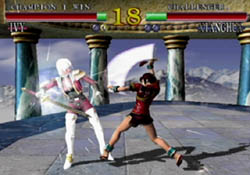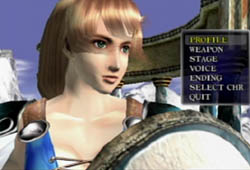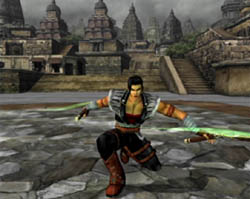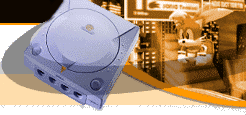| |
Soul Calibur
The Soul Still Burns - Review By Fargo
 The Dreamcast hit the US market like a sledgehammer -- busting sales records with the largest console release in history -- thanks mainly to a sizeable initial software library. Among the first wave of titles there are some significant standouts, games so strong that they alone may sell the system. Count Soul Calibur among them. The Dreamcast hit the US market like a sledgehammer -- busting sales records with the largest console release in history -- thanks mainly to a sizeable initial software library. Among the first wave of titles there are some significant standouts, games so strong that they alone may sell the system. Count Soul Calibur among them.
Soul Calibur is Namco's most recent fighting game, the latest in the SoulEdge/SoulBlade series. The Dreamcast version plays exactly like the version you've seen in the arcades, but this isn't merely a port; Namco spent a great deal of time ensuring that this disk is packed with extras for the people at home. The artwork was redone from scratch, giving you higher res 3D backgrounds, new model animations, new moves and even a couple new playable characters. Yes, the home version is better than the arcade version, even graphically. Hello Dreamcast!
The Good

The game plays as good as it looks. The fighting is both brutal and a little strategic. |
As a two-player fighting game, Soul Calibur polishes rather than innovates. Gameplay is what you'd expect: Two fighters square off in a ring and wail on each other until the loser collapses into a crumpled heap of pudding. The fighting system is very well done and makes great use of the 3D space. You can easily circle around your opponent, which comes in handy. Characters can attack by slashing horizontally or vertically, and their moves are all integrated into the 3D environment, so stepping quickly to one side is a good way to dodge an axe blow coming down toward your head, but it's a bad way to dodge a sideways slash of a sword.
The system of blocking and counter-attacks is well thought out. And because the characters vary widely in size and strength and speed, the game plays very strategically. Small characters have the option of hanging back and waiting for an opportunity to zip in for a few fast strikes, or they can get toe-to-toe with their enemy in order to maintain a continuous volley of quick moves. Larger characters will want to back off and get some breathing room so they can wind-up for devastating strikes. Alternatively they'll try to knock their opponent off the map with their heavier mass. Button-bashing won't get you far against a character who understands the combat system!
Unlike many other fighting games, the combat is very grounded. Characters can only jump a very short distance. Also, there aren't any projectiles -- every move is up close and personal, using pole-arms or bladed weapons. The emphasis is on dodging, blocking, and counter-attacking, not hurling through the air pummeling your opponent with fireballs. We found the strategic combat a hell of a lot more challenging than many other fighters, and the action was still fast-paced enough that there was no shortage of excitement.

The models are superb, surviving even close-up scrutiny. Seen here, Sophita's hair and skirt will blow realistically in the wind, and her lips will move as she speaks. |
Graphically the game is gorgeous. The 3D backgrounds are stunningly rendered with realistic lighting that affects the characters and their shadows. The models are superbly animated using realistic motion-captured fighting moves. There are very few clipping problems with the models; when your hits look like they should connect, they do, and when you miss someone you can see why you didn't connect. That's important for a fighting game.
The single-player game(s) are surprisingly playable, and really add a great deal of life to the title while distinguishing it from the arcade. Aside from playing the "arcade mode" single-player, there's also a "mission battles" mode, which plays a little like a miniature RPG. Your character travels around a large map, finding challenges at each location. To conquer each area you'll have to win a different fight under different conditions. For instance, sometimes your character will be poisoned, losing health as you fight. Or your opponent will be invisible. Dozens of missions are provided, so there's no shortage of challenge or variety.
As rewards in the single-player games, your character gets points that you can spend in an "Art Gallery" on the CD. You use your points to "buy" hundreds of images, ranging from concept art to full-blown paintings of the characters. As you unlock more images, more hidden features of the game become available -- more single-player missions, more selectable levels, more demos, more game modes, and so on. You can even re-edit the opening intro to feature your favorite characters. This game has more polish than a car lot.
The Bad

Hundreds of art-gallery images like these can be unlocked. There's a wealth of background info you can dig up about each character and level in the game. |
We're giving Soul Calibur high marks because we think it's an outstanding example of what the Dreamcast is capable of. There are only a couple of small issues that keep this title from scoring a perfect ten.
Despite the wealth of arenas (Just over a dozen basic arenas, many with multiple variations), all the levels were the same from a playability standpoint. Each level consisted of a roughly square or circular flat platform that you could knock players off of. There was no interaction with the levels; there were no height advantages, obstacles, rivers to wade through, etc. They're beautiful locations but ultimately they all play the same.
The sound was a bit weak in the low-range. We hooked up the Dreamcast to a set of hi-end PC speakers and found that it was lacking in the bass. The sound effects were excellent (such as the clinking of chain armor as one character walked) but lacked the booming, ground-shaking noise that we wanted to hear when the heaviest blows landed. Furthermore, the announcer's voiceover at the end of every fight said only two different phrases -- each of which was equally grating after the 100th fight -- and there was no way to turn the voice off.

This level was gorgeous, but all of the levels played identically. |
Some people will be disappointed by the lack of fatalities. When characters are beaten, they're not killed -- they merely look despondent while the victor poses. This reviewer found that to be a refreshing change, but if you're into blood and gore, you won't find it here. Everyone's limbs stay attached to their body. Similarly, there's no projectiles, which fans of Street Fighter / Mortal Kombat might find boring.
Finally, more variety in the two-player combat would've been exciting. The single-player game implemented all sorts of interesting rules twists, it would've been exciting if these were all options in the multiplayer game -- you and your friends could have a pass-the-poison deathmatch with all unblockable attacks and invisible weapons. Sadly, there are no options to do that.
These issues are all minor quibbles to an otherwise fantastic game. What ultimately counts is good, solid fighting action, something that Soul Calibur isn't lacking in the slightest.
The Final Word
Soul Calibur has a lot to love. The graphics, particularly the character models and animation, are stunning. The fighting is both strategic and intense, fun to watch and fun to play. Multiple game modes, including an extensive single-player campaign, offer a lot of variety not normally found in fighting games. We would've liked to see more interaction in the arenas, but other than that this was a superb example of the Dreamcast at its best. A must-have title!
Developer: Namco
Publisher: Namco
Genre: Fighting
Highs: Awesome graphics and animation. Exciting strategic gameplay. Surprising amount of ways to play single-player.
Lows: Not enough variety with the arenas.
Other: 1-2 Players, VMU Compatible (for saving progress), Jump Pack Compatible, Arcade Stick Compatible, VGA Output Box Support.
|
Final Score:

(out of a possible 10)
|
Visit this Game's Dreamcast Database Entry
Previous Reviews
Comments on this review? Mail Feedback.
|

